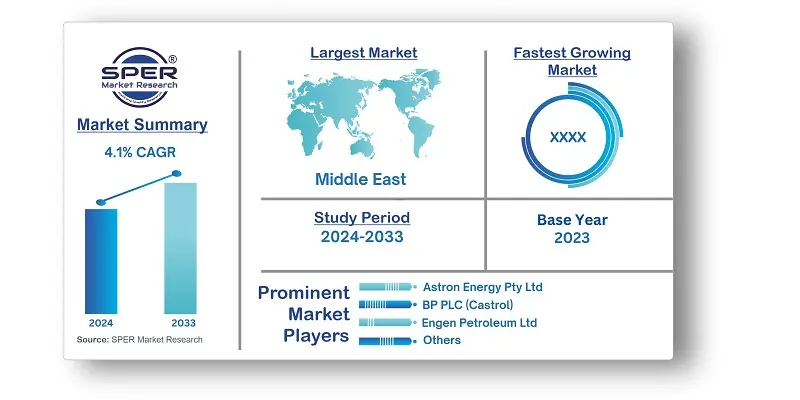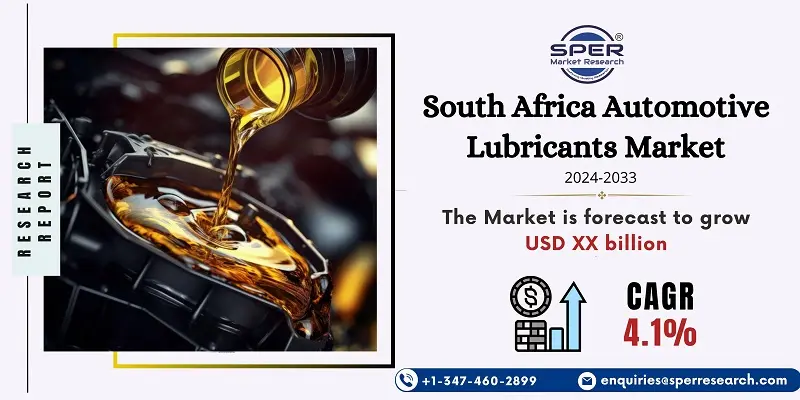
South Africa Automotive Lubricants Market Growth, Size, Trends, Demand and Future Outlook
South Africa Automotive Lubricants Market Size- By Vehicle Type, By Product Type- Regional Outlook, Competitive Strategies and Segment Forecast to 2033
| Published: Sep-2024 | Report ID: AMIN24194 | Pages: 1 - 107 | Formats*: |
| Category : Automotive & Transportation | |||
- April 2022: ExxonMobil Corporation was composed of three business lines: ExxonMobil Upstream Company, ExxonMobil Product Solutions, and ExxonMobil Low Carbon Solutions.
- September 2021: Engen launched its Engen App in a groundbreaking move for its clients' convenience. For the convenience of its customers, Engen will provide all of its goods and services via this app. This should help the company's lubricant sales rise and help it become more well-known in the area.


| Report Metric | Details |
| Market size available for years | 2020-2033 |
| Base year considered | 2023 |
| Forecast period | 2024-2033 |
| Segments covered | By Vehicle Type, By Product Type |
| Regions covered | Eastern Region, Western Region, Northern Region, Southern Region |
| Companies Covered | Astron Energy Pty Ltd, BP PLC (Castrol), Engen Petroleum Ltd, ExxonMobil Corporation, FUCHS, Puma Energy, Q8Oils, Sasol, Shell plc, TotalEnergies, Others. |
- Vehicle Owners and Drivers
- Automotive Repair Shops and Service Centers
- Fleet Operators
- Automotive Manufacturers and Assembly Plants
- Industrial and Commercial Equipment Users
- Distributors and Retailers
| By Vehicle Type: |
|
| By Product Type: |
|
- South Africa Automotive Lubricants Market Size (FY’2024-FY’2033)
- Overview of South Africa Automotive Lubricants Market
- Segmentation of South Africa Automotive Lubricants Market By Vehicle Type (Commercial Vehicles, Motorcycles, Passenger Vehicles)
- Segmentation of South Africa Automotive Lubricants Market By Product Type (Engine Oils, Greases, Hydraulic Fluids, Transmission & Gear Oils)
- Expansion Analysis of South Africa Automotive Lubricants Market
- Problems and Obstacles in South Africa Automotive Lubricants Market
- Competitive Landscape in the South Africa Automotive Lubricants Market
- Impact of COVID-19 and Demonetization on South Africa Automotive Lubricants Market
- Details on Current Investment in South Africa Automotive Lubricants Market
- Competitive Analysis of South Africa Automotive Lubricants Market
- Prominent Players in the South Africa Automotive Lubricants Market
- SWOT Analysis of South Africa Automotive Lubricants Market
- South Africa Automotive Lubricants Market Future Outlook and Projections (FY’2024-FY’2033)
- Recommendations from Analyst
1.1. Scope of the report1.2. Market segment analysis
2.1. Research data source2.1.1. Secondary Data2.1.2. Primary Data2.1.3. SPER’s internal database2.1.4. Premium insight from KOL’s2.2. Market size estimation2.2.1. Top-down and Bottom-up approach
2.3. Data triangulation
4.1. Driver, Restraint, Opportunity and Challenges analysis4.1.1. Drivers4.1.2. Restraints4.1.3. Opportunities4.1.4. Challenges4.2. COVID-19 Impacts of the South Africa Automotive Lubricants Market
5.1. SWOT Analysis5.1.1. Strengths5.1.2. Weaknesses5.1.3. Opportunities5.1.4. Threats5.2. PESTEL Analysis5.2.1. Political Landscape5.2.2. Economic Landscape5.2.3. Social Landscape5.2.4. Technological Landscape5.2.5. Environmental Landscape5.2.6. Legal Landscape5.3. PORTER’s Five Forces5.3.1. Bargaining power of suppliers5.3.2. Bargaining power of buyers5.3.3. Threat of Substitute5.3.4. Threat of new entrant5.3.5. Competitive rivalry5.4. Heat Map Analysis
6.1. South Africa Automotive Lubricants Market Manufacturing Base Distribution, Sales Area, Product Type6.2. Mergers & Acquisitions, Partnerships, Product Launch, and Collaboration in South Africa Automotive Lubricants Market
7.1. South Africa Automotive Lubricants Market Size, Share and Forecast, By Vehicle Type, 2020-20267.2. South Africa Automotive Lubricants Market Size, Share and Forecast, By Vehicle Type, 2027-20337.3. Commercial Vehicles7.4. Motorcycles7.5. Passenger Vehicles
8.1. South Africa Automotive Lubricants Market Size, Share and Forecast, By Product Type, 2020-20268.2. South Africa Automotive Lubricants Market Size, Share and Forecast, By Product Type, 2027-20338.3. Engine Oils8.4. Greases8.5. Hydraulic Fluids
8.6. Transmission & Gear Oils
9.1. South Africa Automotive Lubricants Market Size and Market Share
10.1. South Africa Automotive Lubricants Market Size and Market Share By Region (2020-2026)10.2. South Africa Automotive Lubricants Market Size and Market Share By Region (2027-2033)10.3. Eastern Region10.4. Western Region10.5. Northern Region10.6. Southern Region
11.1. Astron Energy Pty Ltd11.1.1. Company details11.1.2. Financial outlook11.1.3. Product summary11.1.4. Recent developments11.2. BP PLC (Castrol)11.2.1. Company details11.2.2. Financial outlook11.2.3. Product summary11.2.4. Recent developments11.3. Engen Petroleum Ltd11.3.1. Company details11.3.2. Financial outlook11.3.3. Product summary11.3.4. Recent developments11.4. ExxonMobil Corporation11.4.1. Company details11.4.2. Financial outlook11.4.3. Product summary11.4.4. Recent developments11.5. FUCHS11.5.1. Company details11.5.2. Financial outlook11.5.3. Product summary11.5.4. Recent developments11.6. Puma Energy11.6.1. Company details11.6.2. Financial outlook11.6.3. Product summary11.6.4. Recent developments11.7. Q8Oils11.7.1. Company details11.7.2. Financial outlook11.7.3. Product summary11.7.4. Recent developments11.8. Sasol11.8.1. Company details11.8.2. Financial outlook11.8.3. Product summary11.8.4. Recent developments11.9. Shell plc11.9.1. Company details11.9.2. Financial outlook11.9.3. Product summary11.9.4. Recent developments11.10. TotalEnergies11.10.1. Company details11.10.2. Financial outlook11.10.3. Product summary11.10.4. Recent developments11.11. Others
SPER Market Research’s methodology uses great emphasis on primary research to ensure that the market intelligence insights are up to date, reliable and accurate. Primary interviews are done with players involved in each phase of a supply chain to analyze the market forecasting. The secondary research method is used to help you fully understand how the future markets and the spending patterns look likes.
The report is based on in-depth qualitative and quantitative analysis of the Product Market. The quantitative analysis involves the application of various projection and sampling techniques. The qualitative analysis involves primary interviews, surveys, and vendor briefings. The data gathered as a result of these processes are validated through experts opinion. Our research methodology entails an ideal mixture of primary and secondary initiatives.



Frequently Asked Questions About This Report
PLACE AN ORDER
Year End Discount
Sample Report
Pre-Purchase Inquiry
NEED CUSTOMIZATION?
Request CustomizationCALL OR EMAIL US
100% Secure Payment






Related Reports
Our Global Clients
Our data-driven insights have influenced the strategy of 200+ reputed companies across the globe.




















